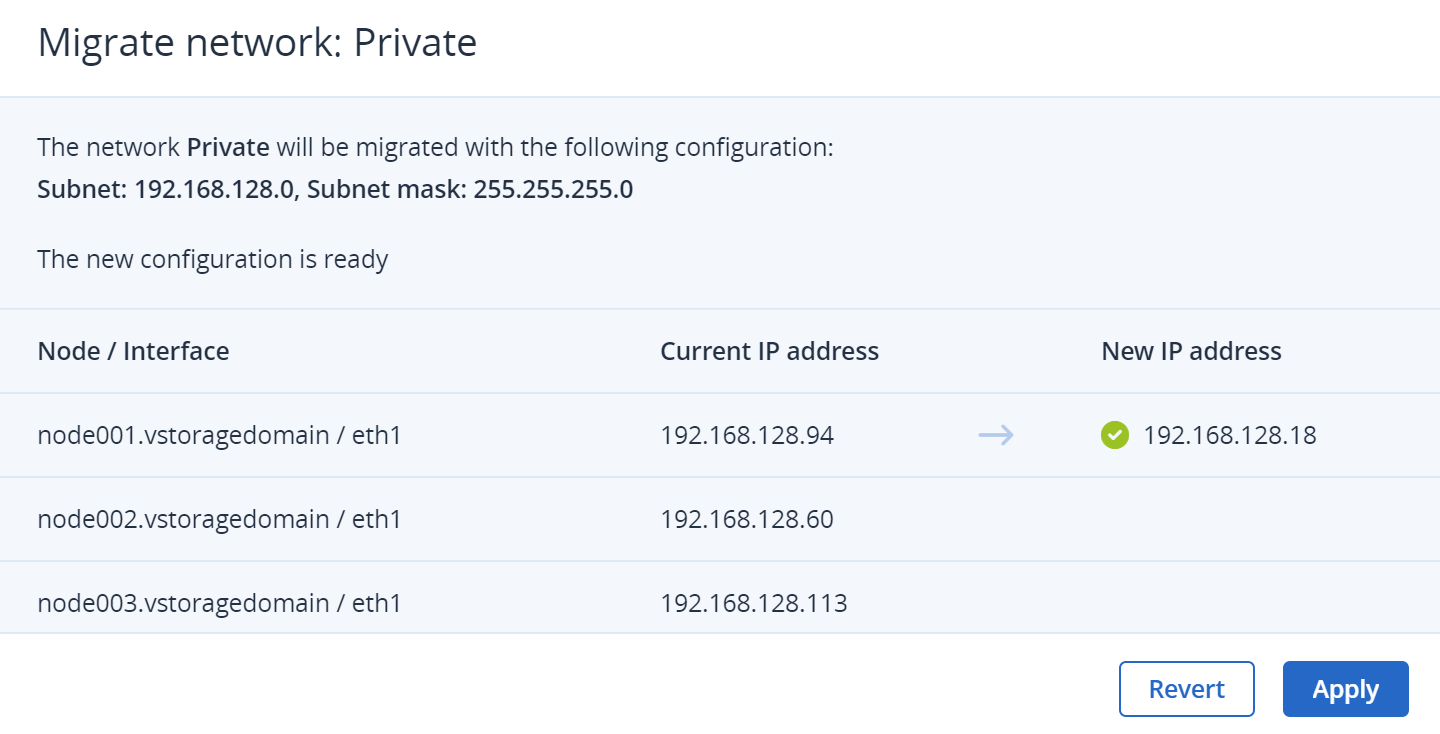3.1. Configuring node network interfaces¶
Before creating the storage cluster, you need to configure the network interfaces on each node.
To configure a network, do the following:
On the Infrastructure > Nodes screen, click the required node name.
Go to the Network tab.
Select a network interface, and then click Configure.
On the Configure pane, do one of the following:
- To obtain the IP address, DNS, and routing settings from the DHCP server, select Automatically (DHCP).
- To obtain just the IP address from the DHCP server, select Automatically (DHCP address only).
- To specify the IP address manually, select Manually and add the IP address.
Warning
Dynamic IP address allocation will cause network issues as soon as the IP addresses of cluster nodes change. Configure static IP addresses from the start or as soon as possible.
Note
For information about configuring RDMA-enabled network interfaces, refer to Enabling RDMA.

If necessary, set up a gateway. The provided gateway will become the node’s default.
If you have set a custom maximum transmission unit (MTU) on the network hardware, set the same value in the corresponding field. Refer to Step 2: Configuring the network for more details.
Warning
Setting a custom MTU in the admin panel prior to configuring it on the network hardware will result in network failure on the node and require manual resetting. Setting an MTU that differs from the one configured on the network hardware may result in a network outage or poor performance.
Click Done to save your configuration.
If you plan to deploy the compute cluster, it is recommended to have two bonded connections, for internal and external communication, and four VLANs over the bond for external traffic (refer to Planning the network). You can create these logical interfaces, as described in Setting up network bonding and Creating VLAN interfaces. Additionally, you can create VLAN network interfaces on the compute nodes by using the automated procedure of VLAN-based network creation outlined in Managing the compute network.
After you configure all network interfaces, go to the Infrastructure > Networks screen and set up networks (refer to Managing networks and traffic types).
Changing network interface configuration after deploying storage or compute services includes network migration of this interface (refer to Migrating networks). In this case, after editing network settings and clicking Done, you will see the migration wizard. Wait until the new configuration is created, and then click Apply.

3.1.1. Setting up network bonding¶
Bonding multiple network interfaces is optional but provides the following benefits:
- High network availability. If one of the interfaces fails, the traffic will be automatically routed through the working interface(s).
- Higher network performance. For example, two bonded Gigabit interfaces will deliver the throughput of about 1.7 Gbit/s or up to 200 MB/s. For a storage node, the required number of network interfaces to bond may depend on the number of disks. For example, an HDD can deliver data at speeds of up to 1 Gbps.
To create a bond, do the following:
On the Infrastructure > Nodes screen, click the name of the node to bond the network interfaces on.
Go to the Network tab.
Select network interfaces to bond, and then click Create bonding.
On the Configure Bonding pane, select the bonding type from the drop-down list. The
balance-xortype is selected by default and recommended for both fault tolerance and good performance.If you are bonding an Open vSwitch-based bridge used in the compute cluster with another network interface, two bonding types will be available:
balance-tcpandactive-backup. In thebalance-tcpmode, load balancing is done based on L2-L4 data like the destination MAC address, IP address, and TCP port. This mode requires that Link Aggregation Control Protocol (LACP) be enabled on the physical switch the node is connected to. In theactive-backupmode, one network interface is active and all other interfaces are passive. If the active interface fails, a passive one becomes active instead.Set up network parameters, as described in step 4 in Configuring node network interfaces, and then click Proceed.
On the Assign network pane, select a network to connect the bonding network interface to (for details, refer to Managing networks and traffic types), and then click Done.
3.1.2. Creating VLAN interfaces¶
To create a VLAN interface on a node, do the following:
- On the Infrastructure > Nodes screen, click the name of the node on which to configure VLAN.
- Go to the Network tab.
- Select a network interface, and then click Create VLAN.
- On the Configure VLAN pane, specify a number for VLAN, add an IP address, and, if necessary, set up a gateway. The provided gateway will become the node’s default. Then, click Proceed.
- On the Assign network pane, select a network to connect the VLAN network interface to (for details, refer to Managing networks and traffic types), and then click Done.
